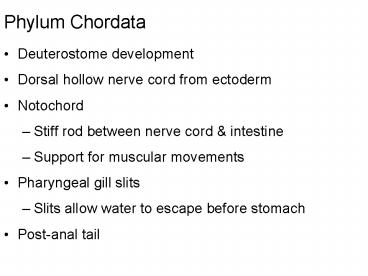Phylum Chordata PowerPoint PPT Presentation
1 / 16
Title: Phylum Chordata
1
Phylum Chordata
- Deuterostome development
- Dorsal hollow nerve cord from ectoderm
- Notochord
- Stiff rod between nerve cord intestine
- Support for muscular movements
- Pharyngeal gill slits
- Slits allow water to escape before stomach
- Post-anal tail
2
Phylum Chordata
- Subphylum Urochordata
- Tunicates (sea squirts)
- Sessile adults filter water with gill slits
- Incurrent excurrent siphons
- Subphylum Cephalochordata
- Lancelets
- Mobile adults bury body in sand w/ mouth out
- Filter-feed across gill slits
3
Subphylum Vertebrata
- Cranium around brain
- Cartilaginous or bony vertebrae around nerve cord
- Except hagfishes
- Diversity of vertebrates
- Superclass Agnatha (hagfish lampreys)
- Jawless fish
- Lack paired appendages
- Cartilaginous skeleton
- Superclass Gnathostomata (jawed mouth)
4
Vertebrata
- Class Chondrichthyes (sharks, rays, skates)
- Cartilaginous fishes
- Some are oviparous (release eggs)
- Some ovoviviparous (release after hatching)
- Some are viviparous (nourished by placenta)
5
Vertebrata
- Class Osteichthyes
- Bony fishes (ossified skeleton)
- Ray-finned, Lobe-finned, lung fishes
- Ray-finned has most species
- Gills covered by operculum
- Swim bladder regulates buoyancy
6
Terrestrial vertebrates
- Class Amphibia
- Amniotes
- Class Reptilia
- Class Aves
- Class Mammalia
7
Class Amphibia
- Tetrapod vertebrates
- Ectothermic
- Developing eggs larva need aquatic environment
- Gas exchange through skin, gills, lungs, /or
mouth - Orders
- Order Anura (frogs toads)
- Order Urodela (salamanders)
- Also caecilians
8
Amniotes
- Amniotic egg contains extra-embryonic membranes
- Amnion surrounds embryo
- Allantois for waste disposal
- Yolk sac stored nutrients for embryonic growth
- Chorion surrounds all these (exchanges gases)
- Allow reproduction away from water
9
Class Reptilia
- Internal fertilization
- Leathery shelled amniotic eggs
- Some have live birth (ovovivipary vivipary)
- No larval stage of development
- Dry, scaly skin
- Lung respiration
- Nitrogenous waste is uric acid
- Ectothermic
10
Class Reptilia
- Order Testudines
- Sea turtles, tortoises, terrapins
- Order Squamata
- Lizards Snakes
- Order Crocodilia
- Crocodiles, caimans, alligators
11
Class Aves
- Hard-shelled egg
- Adapted for flight
- Hollow bones
- Endothermic
- Air sacs in addition to lungs
- No teeth (gizzard does grinding)
- Feathers
- Bipedal (forelimbs are wings)
12
Class Aves
- 29 (or so) living orders with gt8,500 species
- Order Anseriformes (Ducks, geese, swans)
- Order Piciformes (Woodpeckers)
- Order Falconiformes (Hawks, flacons, eagles)
- Order Galliformes (Chickens, turkeys, etc.)
- Order Passeriformes (songbirds)
- Sparrows, finches, cardinals, mockingbirds, jays,
crows, wrens, thrushes, etc
13
Class Mammalia
- Endothermic
- Hair
- Mammary glands
- Some oviparous (egg-laying)
- Monotremes (platypus echidna)
- Most viviparous (nourished by placenta)
- Marsupials
- Eutherians
14
Class Mammalia
- About 4,500 species in 20 orders
- Order Monotremata (platypus echidnas)
- Order Marsupialia (opossums, kangaroo, koala,
etc) - Order Chiroptera (bats)
- Order Carnivora (lions tigers bears!, also
weasels, dogs, raccoons, seals, etc) - Order Cetacea (whales, dolphins)
- Order Rodentia (rats, squirrels, beaver, etc.)
- Order Primates (lemurs, monkeys, apes, you)
15
Order Primates
- Prosimians (e.g. lemurs)
- Old-world monkeys (non-prehensile tails)
- New-world monkeys (prehensile tails)
- Apes
- Gibbons
- Orangutans
- Chimpanzees
- Gorillas
- Humans
16
Homonid evolution
- Bipedalism
- Brain size
- Reduction in sexual dimorphism
- Perhaps with switch to monogamy
- Extended parental care
- Tool use
- Split from other ape ancestor some 5-7 million
y.a. - Diversified into Australopithecus and Homo

